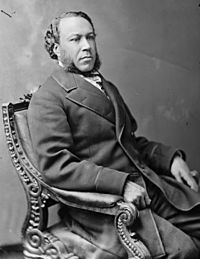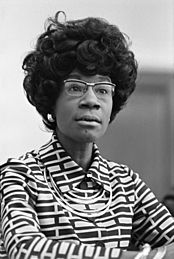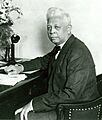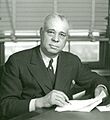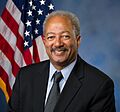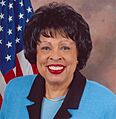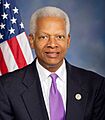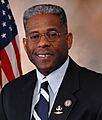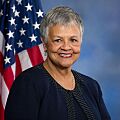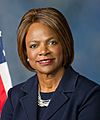List of African-American United States representatives facts for kids
The United States House of Representatives is an important part of the United States Congress. It's like one of the two main groups that make laws for the U.S. government. Over the years, 157 African-American people have been elected to serve in the House. Most of them were representatives from different states. A few were delegates from U.S. territories and Washington, D.C., who can speak but not vote.
The term "African American" includes people who identify with black groups from Africa. In the early days of the U.S., African Americans were not treated as equal citizens. Many were enslaved. No African American could hold a federal elected office until 1870. That's when the Fifteenth Amendment was added to the United States Constitution. This amendment made it illegal to stop someone from voting because of their race or if they had been enslaved before.
Joseph Rainey was the very first African American to join the U.S. House. He started serving in 1870 from South Carolina's 1st congressional district. This was during the Reconstruction era, right after the American Civil War. Later, in 1969, Shirley Chisholm became the first African-American woman elected to the House. She represented New York's 12th congressional district during the Civil Rights Movement.
Many African-American members of the House represent areas where most people are from minority groups. Sometimes, the way these areas are drawn on a map (called gerrymandering) can make it hard for others to win elections there. This can also limit how much they represent everyone in their area. The Voting Rights Act of 1965 helps make sure that minority groups have fair representation. In recent elections, more and more people from minority groups have been elected from areas that aren't mostly minority.
Overall, 31 of the 50 U.S. states, plus the U.S. Virgin Islands and Washington, D.C., have elected an African American to the House. Rhode Island was the most recent state to elect its first in 2023. Also, 23 states, plus the U.S. Virgin Islands and Washington, D.C., have elected an African-American woman. Illinois's 1st congressional district has had African-American representatives continuously since 1928. Right now, there are 58 African-American representatives and two African-American delegates in the House. Most of them are part of a group called the Congressional Black Caucus.
Contents
States with African-American Representatives
This table shows which states have elected African-American members to the U.S. House of Representatives.
| State | Current members | Past members | Total | First African-American member | Party of first member | Years with African-American members |
|---|---|---|---|---|---|---|
| Alabama | 1 | 5 | 6 | Benjamin S. Turner | Republican | 1871–1877, 1993–present |
| Alaska | 0 | 0 | 0 | |||
| Arizona | 0 | 0 | 0 | |||
| Arkansas | 0 | 0 | 0 | |||
| California | 3 | 10 | 13 | Augustus F. Hawkins | Democratic | 1963–present |
| Colorado | 1 | 0 | 1 | Joe Neguse | Democratic | 2019–present |
| Connecticut | 1 | 1 | 2 | Gary Franks | Republican | 1991–1997, 2019–present |
| Delaware | 1 | 0 | 1 | Lisa Blunt Rochester | Democratic | 2017–present |
| Florida | 4 | 8 | 12 | Josiah T. Walls | Republican | 1871–1876, 1993–present |
| Georgia | 5 | 6 | 11 | Jefferson F. Long | Republican | 1871, 1973–1977, 1987–present |
| Hawaii | 0 | 0 | 0 | |||
| Idaho | 0 | 0 | 0 | |||
| Illinois | 4 | 13 | 17 | Oscar Stanton DePriest | Republican | 1929–present |
| Indiana | 1 | 2 | 3 | Katie Hall | Democratic | 1982–1985, 1997–present |
| Iowa | 0 | 0 | 0 | |||
| Kansas | 0 | 0 | 0 | |||
| Kentucky | 0 | 0 | 0 | |||
| Louisiana | 1 | 4 | 5 | Charles E. Nash | Republican | 1875–1877, 1991–2009, 2011–present |
| Maine | 0 | 0 | 0 | |||
| Maryland | 2 | 5 | 7 | Parren Mitchell | Democratic | 1971–present |
| Massachusetts | 1 | 0 | 1 | Ayanna Pressley | Democratic | 2019–present |
| Michigan | 1 | 8 | 9 | Charles Diggs | Democratic | 1955–present |
| Minnesota | 1 | 1 | 2 | Keith Ellison | Democratic–Farmer–Labor | 2007–present |
| Mississippi | 1 | 2 | 3 | John R. Lynch | Republican | 1873–1877, 1882–1883, 1987–present |
| Missouri | 2 | 3 | 5 | Bill Clay | Democratic | 1969–present |
| Montana | 0 | 0 | 0 | |||
| Nebraska | 0 | 0 | 0 | |||
| Nevada | 1 | 0 | 1 | Steven Horsford | Democratic | 2013–2015, 2019–present |
| New Hampshire | 0 | 0 | 0 | |||
| New Jersey | 1 | 2 | 3 | Donald M. Payne | Democratic | 1989–present |
| New Mexico | 0 | 0 | 0 | |||
| New York | 5 | 8 | 13 | Adam Clayton Powell Jr. | Democratic | 1945–present |
| North Carolina | 3 | 8 | 11 | John Adams Hyman | Republican | 1875–1877, 1883–1887, 1889–1893, 1897–1901, 1992–present |
| North Dakota | 0 | 0 | 0 | |||
| Ohio | 3 | 3 | 6 | Louis Stokes | Democratic | 1969–present |
| Oklahoma | 0 | 1 | 1 | J. C. Watts | Republican | 1995–2003 |
| Oregon | 0 | 0 | 0 | |||
| Pennsylvania | 2 | 4 | 6 | Robert N. C. Nix Sr. | Democratic | 1958–present |
| Rhode Island | 1 | 0 | 1 | Gabe Amo | Democratic | 2023–present |
| South Carolina | 1 | 9 | 10 | Joseph Rainey | Republican | 1870–1879, 1882–1887, 1890–1891, 1893–1897, 1993–present |
| South Dakota | 0 | 0 | 0 | |||
| Tennessee | 0 | 2 | 2 | Harold Ford Sr. | Democratic | 1975–2007 |
| Texas | 6 | 5 | 11 | Barbara Jordan | Democratic | 1973–present |
| Utah | 1 | 1 | 2 | Mia Love | Republican | 2015–2019, 2021–present |
| Vermont | 0 | 0 | 0 | |||
| Virginia | 2 | 2 | 4 | John Mercer Langston | Republican | 1890–1891, 1993–present |
| Washington | 1 | 0 | 1 | Marilyn Strickland | Democratic | 2021–present |
| West Virginia | 0 | 0 | 0 | |||
| Wisconsin | 1 | 0 | 1 | Gwen Moore | Democratic | 2005–present |
| Wyoming | 0 | 0 | 0 |
African-American Representatives Through History
African Americans have served in the U.S. House of Representatives during different periods of American history. Here's a look at some of these times.
Reconstruction and Early Post-Reconstruction Era (1870–1887)
This period followed the Civil War. It was a time when African Americans gained more rights. Many Black leaders were elected to office for the first time. Most of them were Republicans. They worked to rebuild the South and protect new freedoms.
- Joseph Rainey from South Carolina was the first to take office in 1870.
- Other notable figures from this era include Jefferson F. Long (Georgia), Robert C. De Large (South Carolina), and John R. Lynch (Mississippi). Many of these early representatives had been enslaved before. They worked hard to make sure Black voices were heard in government.
Late Post-Reconstruction, Populist, and Early Jim Crow Era (1887–1929)
After Reconstruction ended, many African Americans lost their voting rights. This was due to new laws called "Jim Crow" laws. Fewer Black representatives were elected during this time. Those who were elected often faced many challenges.
- Henry P. Cheatham from North Carolina served during this time.
- George Henry White was the last African American to serve in Congress until 1929. He also represented North Carolina. After he left office in 1901, there were no African Americans in Congress for almost 30 years.
Late Jim Crow and Civil Rights Era (1929–1970)
This era saw a slow but steady return of African-American representation. The Civil Rights Movement played a huge role in fighting for equal rights. This led to more opportunities for Black politicians.
- Oscar Stanton De Priest from Illinois was the first African American elected in the 20th century, starting in 1929. He was a Republican.
- Later, Arthur W. Mitchell took his place, becoming the first African-American Democrat in Congress.
- Adam Clayton Powell Jr. from New York was a very influential leader during this time.
- Shirley Chisholm made history as the first African-American woman elected to Congress in 1969.
Modern Era (1971–Present)
Since 1971, the number of African-American representatives has grown significantly. Many have become powerful leaders in Congress. They work on a wide range of issues affecting all Americans.
- Important figures from this period include Barbara Jordan (Texas), John Lewis (Georgia), and Maxine Waters (California).
- Many of these representatives have served for many years. They have helped shape important laws and policies.
- More recently, new faces like Ayanna Pressley (Massachusetts) and Joe Neguse (Colorado) have joined the House.
House Delegates (Non-Voting Members)
Some areas of the U.S., like Washington, D.C., and the U.S. Virgin Islands, have delegates in the House. These delegates can speak and work on committees, but they cannot vote on final laws. African Americans have also served as delegates.
- Walter Fauntroy was the first African-American delegate from Washington, D.C., starting in 1971.
- Currently, Eleanor Holmes Norton represents Washington, D.C., and Stacey Plaskett represents the U.S. Virgin Islands.
African Americans Elected to the House, But Not Seated
Sometimes, an election result is challenged. This means that even if someone wins, they might not be allowed to take their seat. This happened to a few African Americans in the early days.
- John Willis Menard was elected in 1868 from Louisiana. But he was not allowed to take his seat because of a contested election. He was, however, the first African American to speak to the House.
- P. B. S. Pinchback also faced a similar situation in 1872. He was elected from Louisiana but was denied his seat.
Images for kids
More to Explore


